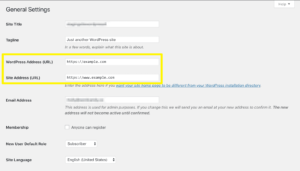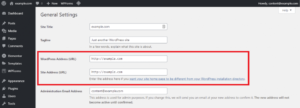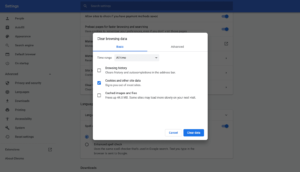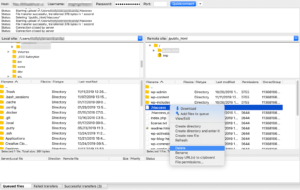About our most secure, flexible plan purpose-built for large teams and organizations
Get Started Now
It’s crucial to understand what a “redirect” is before attempting to fix the WordPress problem ERR_TOO_MANY_REDIRECTS. Essentially, a redirect occurs when one URL is directed to another, which is often used when a post or page is moved to a different address, or when the permalink structure of a site is changed.
For instance, imagine you initially published a post at https://example.com/2024/new-post, but later updated the URL to https://example.com/new-post. In this case, you would set up a redirect from the old URL to the new one, ensuring that anyone attempting to access the original link would automatically be forwarded to the updated address, rather than encountering a 404 error.
However, the ERR_TOO_MANY_REDIRECTS error appears when your website is trapped in a ‘redirect loop’.The browser becomes stuck in an unending loop, for instance, if Page A redirects to Page B and Page B is configured to divert back to Page A. As a result, it becomes impossible to reach either page, as the system continues redirecting indefinitely.
In simpler terms, ERR_TOO_MANY_REDIRECTS means that the website is repeatedly trying to send the browser from one page to another without ever reaching the final destination. This error can prevent users from accessing your site and must be addressed to restore functionality.
This guide will explore the causes of the ERR_TOO_MANY_REDIRECTS error in WordPress, how it manifests in various browsers, and provide solutions to resolve the issue.
Several factors may trigger the ERR_TOO_MANY_REDIRECTS error in WordPress, including:
Though encountering a redirect loop may seem complex, the solution is often straightforward and rooted in misconfigured WordPress settings.
By addressing these common causes and taking the proper steps, you’ll be able to fix the ERR_TOO_MANY_REDIRECTS error and get your WordPress site back on track.

Your WordPress Address specifies where your WordPress core files are installed, while your Site Address is the domain users type into their browsers to access your site. For proper functionality, these two addresses must match precisely. Discrepancies between them can lead to redirect loops.
Ensure that both addresses include the same protocol (HTTP or HTTPS) and subdomain (www or no www). If your WordPress Address, for instance, doesn’t start with “www,” then your site address also shouldn’t.
If these addresses don’t align, update them so they do, and then click “Save Changes” at the bottom of the Settings screen.
Once updated, check your site. The ERR_TOO_MANY_REDIRECTS message or 404 error should be replaced with the correct content.
If adjusting the addresses didn’t solve the problem, you should check your WordPress URL configuration. Redirect loops often occur when incorrect URLs are set, especially during site migrations or domain changes.
You can verify and correct your URL settings through various methods:
You might need to manually change the URL settings if you get the “too many redirects” warning and are unable to access your WordPress admin area. Make the necessary changes and then check your site to see if the issue is resolved.
You can also correct redirect issues by modifying the WordPress URLs directly in the MySQL database using phpMyAdmin. Here’s how:
Use the normal URL (http://example.com/) for websites hosted in the default root folder (/public_html/). Change the URL to http://example.com/wp for websites that are located in subfolders like /wp/.
If you can access your WordPress admin dashboard, you can modify the URL settings directly:
By ensuring these settings are correct, you can effectively address the ERR_TOO_MANY_REDIRECTS error and restore proper site functionality.

Make sure that both the WordPress Address and Site Address are properly configured. After making any changes, don’t forget to save them.
Cookies can sometimes store faulty data, leading to issues like excessive HTTP redirects and blocking access to web pages. Clearing your browser cookies can resolve these problems, whether you’re trying to access your own site or another.
In Google Chrome, follow these steps to delete cookies:
By following these steps, you can eliminate cookies that may be causing redirect issues.

The process for clearing cache and cookies in browsers like Microsoft Edge is generally similar, though the specific menus and options may differ slightly.
If you still experience the redirect error, browser extensions might be causing the issue. Some extensions can disrupt page loading and interactions. To determine whether an extension is to blame for the redirect issue, try disabling each one individually.
Plugin conflicts are a common culprit behind WordPress errors, including the ERR_TOO_MANY_REDIRECTS issue. Identifying the problematic plugin is crucial to fixing the error.
Deactivate All Plugins:
To begin troubleshooting, deactivate all your plugins. You can do this quickly from your WordPress dashboard:
Go to public_html > wp-content > plugins and rename each plugin folder (e.g., rename to “plugin-deactivated”).
Once all plugins are deactivated, begin reactivating them individually:
After reactivating each plugin, check your site to see if the ERR_TOO_MANY_REDIRECTS error reappears. If it does: The most recently reactivated plugin is likely causing the issue.
Once the problematic plugin is identified, you should either remove or replace it to permanently resolve the redirect loop issue.
The .htaccess file can sometimes lead to ERR_TOO_MANY_REDIRECTS errors, particularly in browsers such as Chrome, Firefox, and Safari. Replacing a corrupted .htaccess file may resolve the issue.
Next, connect to your website’s server using an FTP client:
Once you’ve located the .htaccess file:

Make sure your HTTPS configuration is proper in order to avoid ERR_TOO_MANY_REDIRECTS warnings. Incorrect HTTPS setup can cause numerous issues that disrupt site access.
Content Delivery Networks (CDNs) can also cause redirect loops if not configured properly. CDNs improve site load speeds by distributing content globally, but incorrect SSL/TLS settings might inadvertently cause redirection problems.
This guide explored various strategies to resolve redirection issues that can negatively impact user experience and require ongoing wordpress maintenance. From clearing browser caches to checking CDN settings, each step is aimed at ensuring smooth site functionality.
By implementing these solutions, you can effectively address and prevent the ERR_TOO_MANY_REDIRECTS error. If you have questions or additional methods to suggest, please share them in the comments below.
If you found this article helpful, you might also appreciate WPcaps’ 24/7 WordPress website management and support services! Partner with us for comprehensive WordPress support, including speed optimization, unlimited website edits, security, and white-label site management for agencies and freelancers. Our expert team is here to support all your WordPress needs!
A1: The ERR_TOO_MANY_REDIRECTS error is typically caused by a misconfiguration in your WordPress settings, such as incorrect URL settings, plugin conflicts, or issues with your .htaccess file. It can also result from incorrect HTTPS settings or improper CDN configurations.
A2: To fix the error, navigate to Settings > General in your WordPress dashboard and ensure that both the WordPress Address (URL) and Site Address (URL) are correctly configured. They should match exactly and use the same protocol (HTTP or HTTPS) and subdomain (www or no www). Save the changes if needed.
A3: Yes, clearing browser cookies can help resolve the error, especially if the issue is related to excessive HTTP redirects caused by cookie settings.
To clear cookies in Google Chrome, go to Settings > Advanced > Privacy and Security > Clear browsing data, and select Cookies and other site data.
A4: To identify a problematic plugin, deactivate all plugins via the WordPress dashboard or FTP. Then, reactivate them one by one, checking your site after each activation. If the error reappears after activating a specific plugin, that plugin is likely the cause.
A5: If your .htaccess file is causing the error, back up the file and then replace it with a fresh copy from the default WordPress installation. This will reset any custom rules that might be causing the issue. Ensure to review and re-add any necessary custom code afterward.
A6: Incorrect HTTPS settings can lead to redirect loops. Ensure that your site enforces SSL correctly, redirects HTTP traffic to HTTPS properly, and that all site content is served over HTTPS. Also, verify that your SSL certificate is valid and properly installed.
A7: Yes, if your CDN settings don’t align with your server’s settings and SSL configuration, it can cause redirect loops. Double-check your CDN settings to ensure they match your server’s configuration and that there’s no conflict with your HTTPS setup.
A8: If the error persists after trying all the recommended solutions, consider reaching out to your web hosting provider or a WordPress expert for further assistance. They may be able to identify server-level issues or other factors causing the error.
A9: WPcaps offers 24/7 WordPress website management services, including troubleshooting issues like the ERR_TOO_MANY_REDIRECTS error. Our expert team can provide speed optimization, unlimited website edits, and comprehensive security services to ensure your website runs smoothly.
A10: Regularly updating your WordPress core, themes, and plugins, along with monitoring your site’s settings, can help prevent the ERR_TOO_MANY_REDIRECTS error.
Using proper SSL configuration and maintaining accurate URL settings are also key to avoiding this issue.